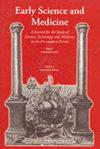Temperament and the Senses: The Taste, Odor and Color of Drugs in Late-Renaissance Galenism
IF 0.5
2区 哲学
Q3 HISTORY & PHILOSOPHY OF SCIENCE
引用次数: 0
Abstract
According to the medical tradition, the temperament of bodies came from the balance of their primary qualities – hot, cold, dry, and moist. However, physicians associated additional sensory properties with temperament in the field of pharmacology. These sensations included taste, color, and odor, which allow an appraisal of the constitution and active powers of drugs. The present paper examines this theme in late-Renaissance medicine, through the accounts of the French physician Jean Fernel (ca. 1497–1558) and the Italian physician Andrea Cesalpino (1519–1603). As will be shown, their respective interpretations of drug “faculties” offered original views on the relationship between temperament, sensory properties, and matter theories. Such discussions, in turn, revealed the Renaissance reception of Arabic-Latin pharmacology, Galenic medicine, and the Aristotelian physics of matter and form.气质与感官:文艺复兴晚期盖伦主义中毒品的味道、气味和颜色
根据医学传统,身体的气质来自于它们的主要品质——热、冷、干、湿的平衡。然而,在药理学领域,医生将额外的感官特性与气质联系起来。这些感觉包括味觉、颜色和气味,通过这些感觉可以对药物的成分和药效进行评估。本文通过法国医生Jean Fernel(约1497-1558)和意大利医生Andrea Cesalpino(1519-1603)的叙述,研究了文艺复兴晚期医学的这一主题。正如将要展示的那样,他们各自对药物“官能”的解释为气质、感官特性和物质理论之间的关系提供了独到的见解。这样的讨论反过来又揭示了文艺复兴时期对阿拉伯-拉丁药理学、盖伦医学和亚里士多德的物质与形式物理学的接受。
本文章由计算机程序翻译,如有差异,请以英文原文为准。
求助全文
约1分钟内获得全文
求助全文
来源期刊

Early Science and Medicine
HISTORY & PHILOSOPHY OF SCIENCE-
CiteScore
0.50
自引率
0.00%
发文量
22
审稿时长
>12 weeks
期刊介绍:
Early Science and Medicine (ESM) is a peer-reviewed international journal dedicated to the history of science, medicine and technology from the earliest times through to the end of the eighteenth century. The need to treat in a single journal all aspects of scientific activity and thought to the eighteenth century is due to two factors: to the continued importance of ancient sources throughout the Middle Ages and the early modern period, and to the comparably low degree of specialization and the high degree of disciplinary interdependence characterizing the period before the professionalization of science.
 求助内容:
求助内容: 应助结果提醒方式:
应助结果提醒方式:


